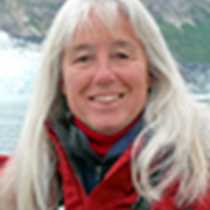National Geographic Explorer positioned to the west side of the Antarctic Peninsula overnight. Cruising in the Gerlache Strait early this morning, we encountered a group of “Little B” killer whales. These are the smallest of the ecotypes, which one day may officially be their own species. Guests emerged on deck in sleeting conditions to observe the animals close to the ship, noticing their yellowish coloration produced by a layer of diatoms.
We continued through Neumayer Channel to Port Lockroy. The area was used as a whaling harbor for 25 years before the British arrived in1944. After an introductory onboard briefing from Kirsty, we went ashore to get an idea of what life was like for the men stationed here between 1944 and 1962. The restored building houses a radio room, bunkrooms, kitchen, lounge, workshop, and souvenir shop, which provides funds for the maintenance of the station. We were able to mail postcards from here, which may arrive by next Christmas! Outside there were gentoo penguins that live in close proximity to the human occupation, even under the buildings, and provided photographic opportunities. Snowy sheathbills, odd white birds that blend in with the surroundings, also challenged our cameras.
Guests switched between the station and Jougla Point, where there were more gentoo penguins, with a few blue-eyed shags on nests interspersed among them. Weddell and leopard seals were hauled-out and resting on the sea ice in the bay, dramatically backdropped by glaciers and mountains.
Danco Island was the afternoon destination, which we visited in a snowstorm, to get some exercise and have fun sliding down the snowy hillside. Gentoo penguins, again, provided entertainment, education, and more chances to make images of these charismatic birds.
Back on board, we continued with recap, conversations, and dinner, looking forward to the next day’s adventures.









